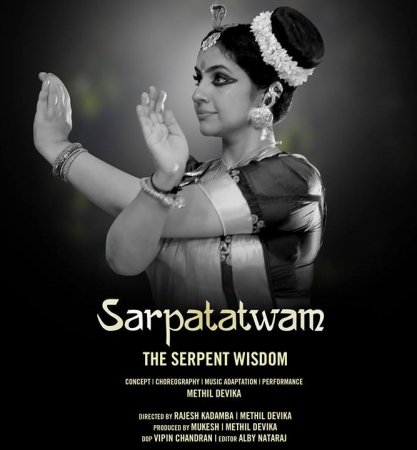
|   |

|   |
Sarpatatwam - Padma Jayaraj e-mail: padmajayaraj@gmail.com March 19, 2020 'Sarpatatwam or The Serpent Wisdom' by Mohiniattam artiste Methil Devika is a dancer's portrayal of serpent allure, the mystique of an ancient cult. The serpent, in the cultural consciousness of the Indian sub-continent, is as old as the Mahabharata, its great epic. Serpent cult originated from animism practiced by the aborigines. And the serpent got incorporated into major religions as new thought waves swept the land. Subsequently, Saivism and Vaishnavism integrated the serpent motif into art, sculpture and temple architecture. The serpent roamed with snake charmers dancing to the rural rhythms of our villages. The snake is part of our Navagrahas influencing our astrological chart which is still vibrant despite modernity. It has its unique temples. The ancestral homesteads of Kerala have a shrine dedicated to the serpent and ritual worship is still part of our culture.  Methil Devika has adopted the philosophic concept of the celebrated Pambatti Siddhar, a mystic physician who lived in 11th c in Tamilnadu. He used the snake as a motif to describe the awakening of the higher self. In Hindu spiritual anatomy, the seven chakras, whirling pools of energy in deeper shades of the vibgyor, is parallel to the spine. The seers are awakened beings as the kundalini, the spiritual power, has risen through these chakras enabling them to see beyond. The rising of the kundalini is likened to the euphoric dancing of the snake. His song, "Oh dance, dance thou cobra...dance playfully...." echoed in art festivals when folk items were popular during my school days. At some point down the years, this particular item gave way to Kaliyamardhanam. Now thanks to Methil Devika, the rural charm gains classical dimension in her documentary film SARPATATWAM. The Mohiniattam format is perhaps the most suited to display its trance like quality seen in the performance of ritual tradition of Kerala, where the serpent dwells in its shrines. Sarpatatwam records the journey of a dance from the folk to the classical, the growth of a spiritual culture from animism to yogic philosophy. Conceptualized and performed by Methil Devika, the dance begins with the famous song echoing like a chant, as the dancer simulates alluring snaky movements. The dance and the song move through the mythical associations that the cult has evoked through centuries as major religious movements accepted and incorporated its mystique, as the snake charmers roamed our world. All along, the refrain, the verses, and the music drums up an enchanting world hinting at the rise of the kundalini that makes a seeker a seer. The music, the refrain, and the verses enrich both the theme and the form as the dance meanders through the realm of serpent lore. The enchanting movements of a dancing snake, as if roused by a divine charmer, highlight the special faculties of the snake, the ability to sense through vibrations, hinting at the spiritual dimension. The second half of the performance introduces its mystical aspect: the serpent worship that is indigenous to Kerala where trance is the climax of the ritual performance. In trance, the altered consciousness predominates, giving an insight into a deeper realm beyond consciousness. Trance inducing music plays a pivotal role in the snake shrine produced by folk instruments in deepening nights creating an ethereal feel. Slow whirling movements erase the design drawn as in the ritual performance. The controlled classical form replaces the frenzy of the folk cult. That the music fails to complement the unique aesthetic experience of the dance is perhaps the only drawback in the documentary. A singing voice, deep and bass would have transcended the visual experience to an elevated level. I missed the haunting strain of the folk pulluvakudam. The dance production as a documentary, as the dancer perceives, is more effective, more in tune with the changing times especially for dissemination. The life of a stage production is short compared to archival film. Besides, in performance filming the technique of close-up highlights different aspects that help a proper study. The interview that closes the documentary answers the questions that a non-Indian might raise for a proper understanding. Set in the natural environs of a snake shrine, in semi darkness, lighted by flaming torches, amid floating dry leaves, the docu-film showcases the perfect ambience that captures the vanishing feudal world of rustic simplicity in the season of autumn. For, in Kerala post-harvest season has preserved and promoted the ritual practice. Like the stage setting, the costume is enhanced by nuances that her jewelry (the necklace, the ear-drops, the bangles both traditional and newly designed) fashions. The young girls who sit in the kalam for the ritual performance enter into a whirling dance as if possessed. Here, of course the dancer, like the temple dancers of yore, is in possession of her faculties although ecstatic. Slow, whirling movements erase the mystique of a created design as if to reveal a fundamental contradiction, philosophic in implication. The dance ends as a tribute paid by the dancer at the portal of high art. As a documentary, Sarpatatwam may cross the bounds of the subcontinent and move beyond.  The team behind the project has done a good job to make the documentary a success. The credits include: Direction by Rajesh Kadamba / Methil Devika, Director of Photography - Vipin Chandran, Editor - Alby Nataraj, Producers - Mukesh / Methil Devika. The musicians featured are Aparna Sharma on vocal, P. Jayasankar on mridangam, V. Soundarrajan on veena, Shrikumar on violin, and Sajith Pappan on edakka/chenda/maddalam. 'Sarpatatwam or The Serpent Wisdom' by Mohiniattam artiste Methil Devika is the first-ever Indian classical dance short-doc to have been voted into the contention list of the Oscar Academy Awards 2019, currently posted in YouTube.  Padma Jayaraj is a freelance writer on the arts and a regular contributor to www.narthaki.com |